Analysis of Correlational Behavior of Solvent and Insolvent Firms Based on Accounting Ratios
人民大2023医学院校研究生英语读与写(第四版)教学课件Unit 10 Text A
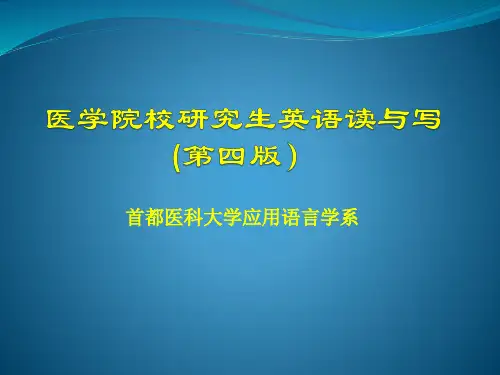
Department of Applied Linguistics Capital Medical University
Text A Personality changes associated with aging
Outline
Background information Global analysis of the text Detailed study of the text Text structure analysis Reference answers to the exercises
Background information
Sigmund Freud
(born May 6, 1856—died September 23, 1939), Austrian neurologist and the founder of psychoanalysis.
Regarded as one of the most important thinkers of the last century, Sigmund Freud was an Austrian neurologist and the founder of psychoanalysis. He revolutionized the study of dreams with his magnum opus book “The Interpretation of Dreams”.
He refined the concepts of unconscious state, juvenile sexuality, and subjugation, and also proposed a three-way theory pertaining to the structure of the mind. Notwithstanding the multiple facets of psychoanalysis as it exists today, it can, in almost all fundamental respects, be traced directly to Freud’s early works.
相关分析CorrelationAnalysis
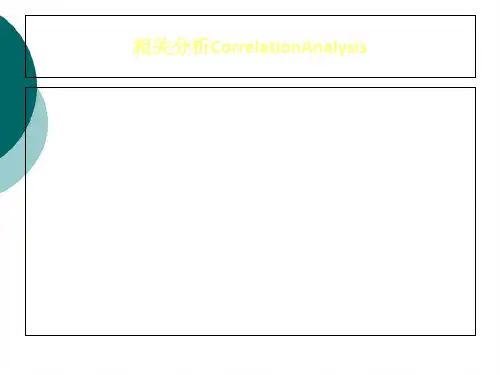
線性關性
兩個連續變數的共變關係,可能有很多 種形式,其中最簡單也是最常見的關聯 型態是線性關係(linear relationship)。
兩個變項的關聯關係可以以一條最具有代表 性的直線來表示
例如:身高與體重,身高越高,體重也越重 Y=bx+a x為身高,y為體重 b為斜率,x每變動一個單位, y的變動量
顯著性 (雙尾)
.
.000
個數
474
474
目前薪資 Pearso n 相關
.661** 1.000
顯著性 (雙尾)
.000
.
個數
474
474
**. 在顯著水準為0.01時 (雙尾),相關顯著。
依Pearson相關係數可知,教育程度和目前薪資的相 關係數為為0.661,P值為0.000。當顯著水準為0.01時, 可以得到教育程度與目前薪資有顯著相關的結論。
目 前 40000 薪 資
20000
0
6
8
10 12 14 16 18 20
22
教育程度(年)
由散佈圖可以很明顯地看出教育程度與目前薪資有正線 性相關。為測量兩變數之線性相關程度,以相關程序求 出兩變數間之相關係數。
相關
教育程度(年) 目前薪資
教育程度(年) Pearso n 相關
1.000
.661**
相关分析CorrelationAnalysis
自變數 類別 類別 連續 連續
依變數 類別 連續 連續 類別
統計分析方法 交叉表 變異數分析 相關分析 迴歸分析
一個例子
很多時候,我們想要知道一件事物與另一 件事物之間的關係(relationship)
而且希望能有個關係指標(index of relationship) 來說明關係強度,指標小關係強度低,指標大 關係強度高;換句話說,需要有個「相關係數」 (coefficient of correlation)
sta correlation analysis
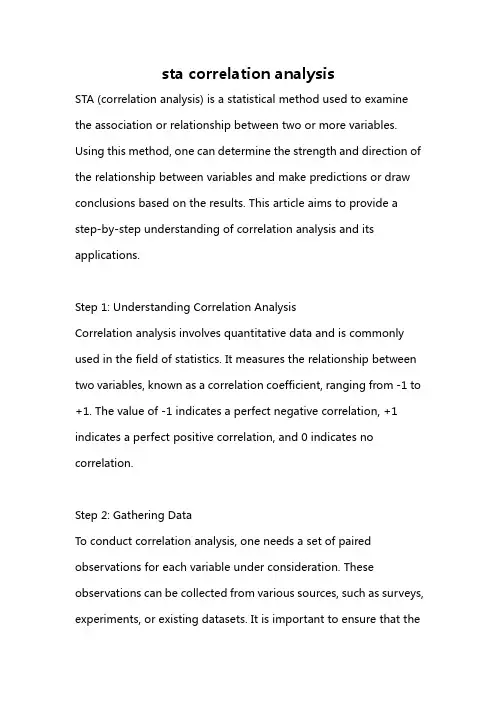
sta correlation analysisSTA (correlation analysis) is a statistical method used to examine the association or relationship between two or more variables. Using this method, one can determine the strength and direction of the relationship between variables and make predictions or draw conclusions based on the results. This article aims to provide a step-by-step understanding of correlation analysis and its applications.Step 1: Understanding Correlation AnalysisCorrelation analysis involves quantitative data and is commonly used in the field of statistics. It measures the relationship between two variables, known as a correlation coefficient, ranging from -1 to +1. The value of -1 indicates a perfect negative correlation, +1 indicates a perfect positive correlation, and 0 indicates no correlation.Step 2: Gathering DataTo conduct correlation analysis, one needs a set of paired observations for each variable under consideration. These observations can be collected from various sources, such as surveys, experiments, or existing datasets. It is important to ensure that thedata collected is reliable and representative of the population of interest.Step 3: Calculating the Correlation CoefficientOnce the data is gathered, the next step is to calculate the correlation coefficient. There are different types of correlation coefficients, such as the Pearson correlation coefficient and the Spearman correlation coefficient.The Pearson correlation coefficient is used when the variables are normally distributed and have a linear relationship. It is calculated using the formula:r = (Σ(Xi - X̄)(Yi - Ŷ))/(√(Σ(Xi - X̄)²)√(Σ(Yi - Ŷ)²))Where Xi and Yi are the observed values for variables X and Y, X̄and Ŷare the respective means, and Σdenotes the summation across all observations.The Spearman correlation coefficient is used when the variables do not meet the assumptions of normality or have a non-linear relationship. Instead of using the actual values, it calculates the rank of each observation to determine the relationship.Step 4: Analyzing the Correlation Coefficient's SignificanceOnce the correlation coefficient is calculated, the next step is to determine if the relationship is statistically significant. The significance of correlation can be tested using hypothesis testing with the help of statistical software or statistical tables.The hypothesis testing involves defining the null hypothesis (H0), which assumes no correlation between the variables, and the alternative hypothesis (Ha), which assumes a non-zero correlation. If the calculated correlation coefficient falls within the critical region, the null hypothesis is rejected, indicating a statistically significant relationship.Step 5: Interpreting the Correlation CoefficientAfter determining the significance, it is essential to interpret the correlation coefficient. The sign of the coefficient (+/-) indicates the direction of the relationship. If the coefficient is positive, it implies a positive relationship, i.e., an increase in one variable corresponds to an increase in the other. Conversely, a negative coefficient implies a negative relationship, where an increase in one variable corresponds to a decrease in the other.The magnitude of the correlation coefficient indicates the strength of the relationship. A value close to +1 or -1 suggests a strong correlation, while a value close to 0 indicates a weak or no correlation.Step 6: Drawing Inferences and ApplicationsWith the correlation coefficient and its significance determined, one can draw inferences about the relationship between variables. Correlation analysis is widely used in fields such as economics, social sciences, and healthcare to explore various phenomena and make predictions.For example, in economics, correlation analysis can help determine the relationship between variables such as income and expenditure, interest rates and investments, or population growth and GDP. In social sciences, it can be used to explore correlations between variables such as education level and income, crime rates, and poverty levels. In healthcare, correlation analysis can be used to examine the relationship between variables such as smoking and lung cancer or blood pressure and heart disease.In conclusion, correlation analysis is a valuable statistical tool for examining relationships between variables. By following the steps outlined above, researchers can assess the strength and direction of relationships, determine their significance, and make meaningful inferences. Understanding correlation analysis is crucial for making informed decisions and drawing accurate conclusions in various fields.。
decay of correlation 数学名词
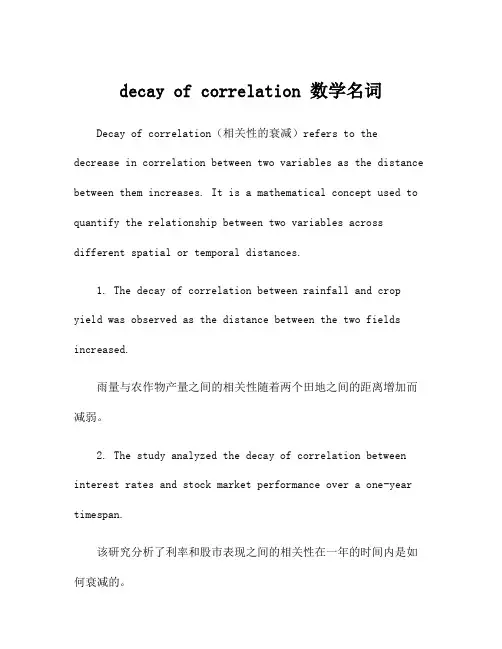
decay of correlation 数学名词Decay of correlation(相关性的衰减)refers to the decrease in correlation between two variables as the distance between them increases. It is a mathematical concept used to quantify the relationship between two variables across different spatial or temporal distances.1. The decay of correlation between rainfall and crop yield was observed as the distance between the two fields increased.雨量与农作物产量之间的相关性随着两个田地之间的距离增加而减弱。
2. The study analyzed the decay of correlation between interest rates and stock market performance over a one-year timespan.该研究分析了利率和股市表现之间的相关性在一年的时间内是如何衰减的。
3. As the distance between two cities increased, thedecay of correlation between their population sizes became more noticeable.随着两个城市之间的距离增加,它们的人口规模之间的相关性衰减变得更加明显。
4. The researchers used statistical methods to determine the decay of correlation between air pollution andrespiratory diseases in different neighborhoods.研究人员使用统计方法来确定不同社区之间空气污染和呼吸道疾病之间的相关性衰减。
心理学专业英语词汇(C3)_2068
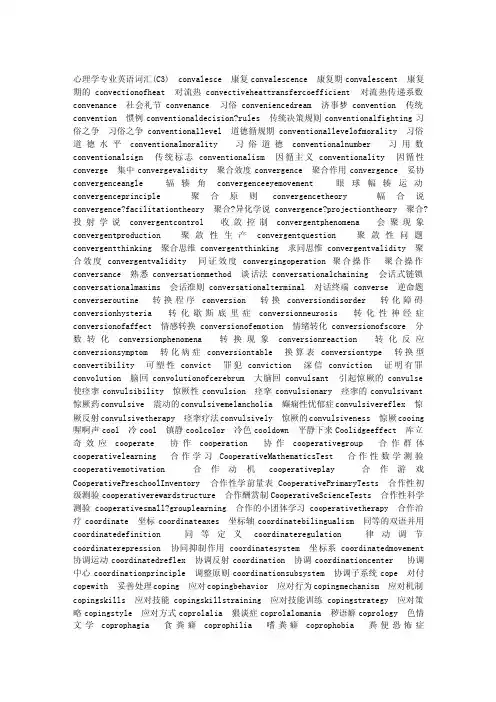
心理学专业英语词汇(C3) convalesce 康复convalescence 康复期convalescent 康复期的convectionofheat 对流热convectiveheattransfercoefficient 对流热传递系数convenance 社会礼节convenance 习俗conveniencedream 济事梦convention 传统convention 惯例conventionaldecision?rules 传统决策规则conventionalfighting习俗之争习俗之争conventionallevel 道德循规期conventionallevelofmorality 习俗道德水平conventionalmorality 习俗道德conventionalnumber 习用数conventionalsign 传统标志conventionalism 因循主义conventionality 因循性converge 集中convergevalidity 聚合效度convergence 聚合作用convergence 妥协convergenceangle 辐辏角convergenceeyemovement 眼球幅辏运动convergenceprinciple 聚合原则convergencetheory 幅合说convergence?facilitationtheory 聚合?异化学说convergence?projectiontheory 聚合?投射学说convergentcontrol 收敛控制convergentphenomena 会聚现象convergentproduction 聚敛性生产convergentquestion 聚敛性问题convergentthinking 聚合思维convergentthinking 求同思惟convergentvalidity 聚合效度convergentvalidity 同证效度convergingoperation聚合操作聚合操作conversance 熟悉conversationmethod 谈话法conversationalchaining 会话式链锁conversationalmaxims 会话准则conversationalterminal 对话终端converse 逆命题converseroutine 转换程序conversion 转换conversiondisorder 转化障碍conversionhysteria 转化歇斯底里症conversionneurosis 转化性神经症conversionofaffect 情感转换conversionofemotion 情绪转化conversionofscore 分数转化conversionphenomena 转换现象conversionreaction 转化反应conversionsymptom 转化病症conversiontable 换算表conversiontype 转换型convertibility 可塑性convict 罪犯conviction 深信conviction 证明有罪convolution 脑回convolutionofcerebrum 大脑回convulsant 引起惊厥的convulse 使痉挛convulsibility 惊厥性convulsion 痉挛convulsionary 痉挛的convulsivant 惊厥药convulsive 震动的convulsivemelancholia 癫痫性忧郁症convulsivereflex 惊厥反射convulsivetherapy 痉挛疗法convulsively 惊厥的convulsiveness 惊厥cooing 喔啊声cool 冷cool 镇静coolcolor 冷色cooldown 平静下来Coolidgeeffect 库立奇效应cooperate 协作cooperation 协作cooperativegroup 合作群体cooperativelearning 合作学习CooperativeMathematicsTest 合作性数学测验cooperativemotivation 合作动机cooperativeplay 合作游戏CooperativePreschoolInventory 合作性学前量表CooperativePrimaryTests 合作性初级测验cooperativerewardstructure 合作酬赏制CooperativeScienceTests 合作性科学测验cooperativesmall?grouplearning 合作的小团体学习cooperativetherapy 合作治疗coordinate 坐标coordinateaxes 坐标轴coordinatebilingualism 同等的双语并用coordinatedefinition 同等定义coordinateregulation 律动调节coordinaterepression 协同抑制作用coordinatesystem 坐标系coordinatedmovement 协调运动coordinatedreflex 协调反射coordination 协调coordinationcenter 协调中心coordinationprinciple 调整原则coordinationsubsystem 协调子系统cope 对付copewith 妥善处理coping 应对copingbehavior 应对行为copingmechanism 应对机制copingskills 应对技能copingskillstraining 应对技能训练copingstrategy 应对策略copingstyle 应对方式coprolalia 猥谈症coprolalomania 秽语癖coprology 色情文学coprophagia 食粪癖coprophilia 嗜粪癖coprophobia 粪便恐怖症coprostasophobia 便秘恐怖症copulation 交配copy 复制copy 广告用语copychoice 样板选择copytest 广告用语测验cordial 兴奋的cordialfeeling 亲切感cordialmedicine 兴奋剂core 核心coreconstruction 核心建构coreinstitution 核心机构coretemperature 核心温度corevalues 核心价值观corium 真皮cornea 角膜corneareflex 角膜反射cornealastigmatism 角膜性散光cornealreflection 角膜反射cornealreflectionmethod 角膜反射法Cornellmedicalindex 康纳尔医学指数Cornsweetillusion 康士维错觉corollary 推论corollarydischarge 推测放电coronaryheartdisease 冠心病coronarypronebehavior 冠心病行为coronarypronebehaviorpattern 冠心病行为型式corporabigemina 二叠体corporaquadrigemina 四叠体corporal 肉体的corporalpunishment 体罚corporateaction 协同行动corporateecology 企业生态学corporateenvironment 企业环境corporateimage 企业映象corporeal 肉体的corpulence 肥胖corpusalbicans 乳头体corpusamygdaloideum 杏仁核corpuscallosum 胼胝体corpusciliare 睫状体corpusgeniculatumlaterale 外侧膝状体corpusgeniculatummediale 内侧膝状体corpusluteum 黄体corpuspineale 松果体corpusstriatum 纹状体corpusvitreum 玻璃体corpuscle 小体corpuscles 触觉小体correct 矫正correct 校正correctassociationmethod 联对法correctrejection 正确否定correctedeffectivetemperature 校正的有效温度correction 矫正correctioncoefficient 校正系数correctionexercises 矫正体操correctionfactor 校正因素correctionforattenuation 衰减校正correctionforcontinuity 连续性校正correctionforgrouping 归组校正correctionforguessing 猜测校正CorrectionFormTest 校正式测验correctionformtest 校正式检查correctionmethod 矫正法correctionofcontinuity 连续性校正correctionofconvict?smind 罪犯心理矫治correctionprocedure 矫正法correctionaleducation 矫正教育correctionalpsychology 矫治心理学correctitude 端正corrective 矫正的correctiveemotionalexperience 矫正情感体验correctivemeasure 矫正措施correctivemethod 矫正法correctiveteaching 矫正教学corrector 校正者correlate 相关correlatedcolortemperature 相关色温correlatedcondition 相关条件correlatedcurriculum 相关课程correlatedobservation 相关观察correlatedresponse 相关反应correlatedsamples 相关样本correlation 相关correlationanalysis 相关分析correlationbetweenrelative 亲缘间相关correlationbyrank 等级相关correlationcenter 关联中枢correlationcoefficient 相关系数correlationdiagram 相关图correlationgraph 相关图表correlationmatrix 相关距阵correlationmethod 相关法correlationofindices 指数相关correlationofsurface表面相关表面相关correlationratio 相关比correlationscatterdiagram 相关散布图correlationstudy 相关研究correlationtable 相关表correlationtheory 相关理论correlationalanalysismethod 相关分析法correlationalmethod 相关法correlationalpsychology 相关心理学correlationalresearch 相关研究correlationalstudy 相关研究correlativity 相关性correlogram 相关图correspondence 符合correspondingpoint 对应点correspondingretinalpoint 网膜对应点corrigent 矫正的corrigibility 矫正corrigible 可矫正的corrigibly 矫正的cortex 皮质cortexofcerebellum 小脑皮质cortexofcerebrum 大脑皮质cortiadrenal 肾上腺皮质corticalalexia 皮质性失读corticalaphasia 皮质性失语症corticalapraxia 皮质性运用不能corticalareas 皮质区corticalblindness 皮质性盲corticalcenter 皮层中枢corticalcontrol 皮质控制corticaldeafness 皮质性聋corticalEEG 皮层脑电图corticalelectroencephalogram 皮层脑电图corticalevokedpotential 皮质引发电位corticalhormone 皮质激素corticallayer 皮层corticalneuron 皮层神经元corticalreaction 皮层反应corticalreflex 皮层反射corticalsensoryaphasia 皮质感觉性失语症corticalsubstance 皮质corticaltype 皮质型corticalization 皮质形成corticectomy 脑皮层切除术corticotropin?regulatoryfactor 促皮质素调节因子corticoadrenal 肾上腺皮质的corticobulbar 皮质延髓的corticocerebral 大脑皮质的corticodiencephalic 皮质间脑的corticofugal 离皮质的corticoid 皮质激素类corticoidlevel 皮质激素水平corticomesencephalic 皮质中脑的corticopeduncular 皮质大脑脚的corticopetal 向皮层的corticopetal 向皮质的corticopontine 皮质脑桥的corticospinaltract 皮质脊髓束corticosteroid 皮质类甾醇corticosterone 皮质甾酮corticothalamic 皮质丘脑的corticotrophic 促肾上腺皮质的corticotrophinhormone 促肾上腺皮质激素corticotrophinreleasingfactor 促皮质素释放因子corticotropic 促肾上腺皮质的corticotropichormone 促肾上腺皮质激素corticotropin 促皮质素cortico?afferent 向皮质传入的cortico?bulbarfibre 皮质延髓束cortico?efferent 皮质传出的cortico?integration 皮质整合作用cortico?pontilefibre 皮质?脑桥纤维cortico?spinalfibre 皮质?脊髓纤维cortico?spinaltract 皮质?脊髓束cortico?visceral 皮质内脏的cortico?visceraltheory 皮质内脏相关说cortin 肾上腺皮质激素cortisol 皮质醇cortisone 可的松cortisoneacetate 醋酸可的松Corti?sganglion 柯蒂神经节Corti?sganglion 螺旋神经节Corti?smembrane 耳蜗腹膜Corti?sorgan 柯笛器官corybantism 精神狂乱cosensitize 多敏感cosensitize 共同敏感cosher 娇养cosiness 舒适cosmism 宇宙进化论cosmology 宇宙论cosmonautics 宇宙航行学cosmopolitanismtheory 宇宙泛生学说cosmos 宇宙cosset 宠爱cost 代价costanalysis 成本分析costive 迟缓的cost?minimizationstrategy 成本最小化战略cost?rewardanalysisofhelpingbehavior 助人得失分析cosyntropin 促皮质素Cotard?ssyndrome 科塔尔综合症Cotunniusaqueduct 科图尼约前庭小管Cotunniusspace 科图尼约间隙couch 教练员coueism 自我暗示counsel 咨询counselee 受辅者counselee?centeredcounseling 受辅者中心咨询counseling 咨询counselinginterview 咨询面谈CounselingPsychologist 咨询心理学家?谘商心理学家?counselingpsychology 咨询心理学counselingrelationship 咨询关系counselingtechniques咨询方法谘商方法counselor 咨询者counselorrole 咨询员角色counselor?centeredtherapy 咨询员中心治疗法count 计算countdown 倒数countenance 脸部表情countenance 赞同counter 对立的counterbalancingmethod 反平衡法countercamouflage 反伪装counterconditioning 对抗性条件作用counterconformitybehavior 抗遵从行为counteridentity 对抗同一性counterrole 对抗作用counteract 对抗counteraction 颉抗作用counteractionneed 反败需求counterattitudinal 逆态度的counterbalance 等衡counterbalance 抗衡counterbalancedexperimentalconditiondesign 实验条件平衡设计counterbalancedpresentationmethod 平衡安排法counterbalancedprocedure 抵消程序counterbalancedprocedure 平衡法counterchange 使交错counterclockwise 反钟向counterconditioning 对抗性条件作用counterculture 对照文化counterculture 逆主流文化counterego 反向自我counterintuitive 反直觉的counterirritant 抗刺激的counterirritantion 对抗刺激作用counterphobia 对抗恐怖症counterphobicbehavior 反恐怖行为counterpointofsoundandpicture 声画对位counterpoise 平衡counterpropaganda 反宣传counterrole 对抗作用counterstimulus 反促进因素反促进因素countersuggestion 反暗示counterterorism 报复性恐怖主义counterterorist 报复性恐怖主义者counterterror 反恐怖countertransference 反移情作用countervail 补偿counter?actingforce 反作用力counter?cathexis 反向性力投付counter?conditioningprocedure 对抗性条件作用法counter?culture 对抗性文化counter?intuitive 反直观的counter?measureofmixedmotivation 混合动机对策counter?penetratingaction 反贯串动作counter?suggestion 反暗示counter?transference 逆转移counter?typeadder 累加型加法器counter?wishdream 违愿梦counting 计算countingbackwardtechnique 倒数法countingframe 算盘couple 配偶coupletherapy 夫妇心理治疗coupletherapy 配偶治疗法coupledinhibition 偶联抑制couplingmedium 成对传递体courage 勇敢course 过程courseevaluation 课程评鉴courtpsychology 法庭心理学courtesy 礼貌courtroompsychology 法庭心理学courtship 求爱courtshipbehavior 求偶行为courtshipdisplay 求爱表示cousin 表亲cousinmarriage 表亲结婚couth 有教养的covariance 协方差covarianceanalysis 协方差分析covariancematrix 协方差距阵covariancemethod 共变法covariancemethod 协方差法covarianceprinciple 共变原理covarianceruleofattribution 归因共变原则covariation 协变coverstory 表面理由coverage 范围covert 隐蔽的covertbehavior 内隐行为covertconditioning 内隐条件法covertculture 隐蔽文化covertdesensitization 内隐减敏法covertextinction 内隐消弱法covertintrusion 隐性侵入covertmodelingtherapy 内部示范治疗covertneed 内隐需求covertrandomization 隐秘的随机化covertreinforcement 内隐强化法covertresponse 内隐反应covertspeech 内隐言语covet 妄想covetous 贪婪的cow 威胁coward 懦夫cowardice 懦弱cower 畏缩Cox?StuartTestforTrend 柯?斯二氏倾向测验coy 怕羞的cozen 欺骗cozy 舒适的co?actingeffect 协作效应co?actinggroup 同工群co?actinggroup 协作集体co?actioneffect 同动效应co?actor 同工者co?actor 协作者co?conscious 共同意识co?consciousness 并行意识co?education 男女同校教育co?optation 纳入co?orientationprocess 互为关注过程co?satiation 伴同餍足co?twincontrolmethod 孪生控制法CPK 肌酸磷酸激酶CPMScale CPM量表CPMtheory CPM理论CPMtheory 品德绩效维系理论CR 临界比CR 条件反射CR 条件反应crab 脾气乖戾的crabber 爱发牢骚的人crabby 脾气坏的crack 神经错乱的crackup 失去控制crackers 发疯的crackpot 古怪的craftiness 狡猾Cramer?scoefficientofcontingency 克拉默列联系数crammer 死记硬背的人cramming 死记硬背cramp 痉挛cranial 脑的cranialarachnoid 脑蛛网膜cranialcapacity 脑容量cranialcavity 颅腔cranialnerve 脑神经cranialnervenuclei 脑神经核craniocerebral 颅脑的craniology 颅骨学craniometer 颅测量器craniometry 头颅测量法cranioscope 颅检查器cranioscopy 颅检查术craniospinalnerves 颅脊神经craniotomy 颅骨切除术cranium 颅crankwheel 曲柄轮crapulence 酗酒crassitude 愚钝crater 壁龛crave 渴望craving 瘾cravingforknowledge 求知欲cravingforstimulus 对刺激的渴求CrawfordSmallPartsDexterityTest 克劳福特零件操作灵活性测验craze 狂热createdimaga 创造映象creatinephosphokinase 肌酸磷酸激酶creation 创造creationism 神造论creativeability 创造能力creativeactivity 创造性活动creativearts 创造艺术creativeattitude 创造态度creativeconsciousness 创造性意识creativeDarwinism 创造性达尔文主义creativeengineering 创造工程学creativeenthusiasm 创作热情creativeevent 创造事件creativeevolution 创世进化creativeexpression 创造性表达creativeimagination 创造想象creativeimpulse 创造冲动creativeintelligence 创造性智慧creativelearning 创造性学习creativemodeling 创造模式creativeobjectives 创造性目标creativeorganization 创造的组织creativepersonality 创造性人格creativeplay 创造性游戏creativeproblemsolvingmodels 创造性问题解决模式creativereading 创造性阅读creativeresultant 创造成果creativeselection 创造性选择creativeself 创造性自我creativesynthesis 创造性综合症creativethinking 创造性思考creativetraining 创造力训练creativeness 创造性creativity 创造力creativity 创造性creativitymeasurement 创造力测量creativitytest 创造力测验creativitytraining 创造力训练creature 创造物creche 日间托儿所credentialism 履历至上主义credentialism 文凭主义credibility 可信度credit 信誉credo 信条credulity 轻信creophagism 肉食Crespieffect 克雷斯比学习效应crest 波峰crestofsonority 响音顶点cretin 克汀病cretinism 矮呆症cretinism 克汀病cretinous 呆小病的crew 机组人员crewdepartment 驾驶舱室CRF 促皮质素释放因子cribdeath 婴儿暴毙症crime 犯罪crimebyoldpeople 老年犯罪crimeduetoabnormalmind 变态心理犯罪crimeduetoaffectivedisturbance 感情障碍犯罪crimeduetoconsciousdisturbance 意识障碍犯罪crimeduetointelligencedisturbance 智力障碍犯罪crimeduetomentaldisease 心智障碍犯罪crimeduetopassionateimpulse 激情犯罪crimeduetoperceptualdisturbance 感知障碍犯罪crimeduetosexabnormality 性变态犯罪crimeduetothoughtdisturbance 思维障碍犯罪crimeduetovolitionalbehaviordisturbance 意志行为犯罪crimeofdelusionaltype 妄想型犯罪crimeofpassion 激情犯罪crimewithamusementmotive 游乐性动机犯罪crimewithcuriositymotive 好奇心动机犯罪crimewithdefensivemotive 防卫动机犯罪crimewithfriendshipmotive 友情动机犯罪crimewithgreedy?for?moneymotive 贪财动机犯罪crimewithindignationmotive 义愤动机犯罪crimewithjealousymotive 嫉妒性动机犯罪crimewithsexmotive 性动机犯罪crimewithsuspiciousmotive 猜疑性动机犯罪crimewithtalionmotive 报复性动机犯罪criminal 犯罪的criminalanthropology 犯罪人类学criminalattitude 犯罪态度criminalbehavior 犯罪行为criminalclinic 犯罪诊疗criminaldetermination 犯罪决意criminalenvironment 犯罪环境criminalgang 犯罪团伙criminalgroup 犯罪集团criminalimpulse 犯罪冲动criminalmentality 犯罪心理criminalmind 犯罪心理criminalmotivation 犯罪动机criminalpersonality 犯罪人格criminalpremeditation 犯罪预谋criminalpsychiatry 犯罪精神病学criminalpsychology 犯罪心理学criminalresponsibility犯罪责任犯罪责任criminalsociology 犯罪社会学criminalsubculture 犯罪次文化criminalsurplus 犯罪过剩criminaltheories 犯罪理论criminaltheoryofemotionaldisorder 情绪障碍犯罪说criminaltype 犯罪型criminalistics 犯罪侦察学criminality 犯罪性行为criminology 犯罪学crippled 残疾者crippledchild 残疾儿crippledleap?frogtest 踏步检验crisis 危机crisiscounseling 危机咨询crisisinmid?age 中年危机crisisintervention 危机干预crisisofpregnancy 妊娠危机crisistendencies 危机趋向crisistheory 危机论crisistherapy 危机治疗法cristaampullaris 壶腹嵴criterion 效标criterion 准则criterionbehavior 准则行为criterioncontamination 效标污染criterionforsampling 抽样准则criteriongroup 标准组criteriongroup 效标组criterionkeying 评准辨分法criterionmeasure 评准尺度criterionmeasure 效标量数criterionofconduct 行为准则criterionofidentification 识别标准criterionofinternalconsistency 内部一致准则criterionreferencedtest 标准参照测验criterionscore 标准分数criterionscore 效标量数criterionvalidity 效标效度criterionvariable 标准变量criterionvariable 效标变量criterion?orientedvalidity 效标取向效度criterion?referencedevaluation 标准参照评量criterion?referencedgrading 标准参照记分法criterion?referencedmeasurement 规范测量criterion?referencedtest 标准参照测验criterion?referentialtest 准则参照测验criterion?relatedvalidity 效标关联效度critical 关键的critical 临界的criticalage 危机年龄criticalband 临界带criticalcoefficient 临界系数criticalcolorfusionfrequency 颜色临界融合频率criticalconstant 临界常数criticaldepth 临界深度criticaldistance 临界距离criticalevents 关键事件criticalflickerfrequency 临界闪烁频率criticalflickerfusionfrequency 临界闪烁融合频率criticalflickerfusionthreshold 临界闪烁融合阈限criticalfusionfrequency 临界融合频率criticalfusionpointintaste 味觉融合临界点criticalincident 危机事件criticalincidentmethod 关键事件法criticalincidenttechnique 决定性事件法criticalincidenttechnique 临界事故法criticallevel 临界水平criticalnumber 临界值criticalperiod 关键期criticalpersons 关键人物criticalpoint 临界点criticalpsychologicalstates 关键的心理状态criticalratio 临界比criticalregion 临界区域criticalscore 关键分数criticalstate 临界状态criticalstimulus 关键刺激criticaltable 判定表criticaltemperature 临界温度criticalthinking 判断思维criticalthinkingappraisal 批判性思考评估criticalvalue 临界值criticalvelocity 临界速度criticalness 批判性criticalnessinself?evaluation 自我评价批判性criticism 批评criticismlesson 评导教学cri?du?chat?syndrome 猫叫综合症Cronbach?sα coefficient 克伦巴赫α系数cross 交叉crossaction 交互作用crossadaptation 交叉适应crossclassification 交叉分类crosseducation 交叉教育crossexamination 严诘考试crossextensionreflex 交叉伸展反射crossformula 交叉公式crossmaze 十字迷津crossovermodel 交叉模型crossreaction 交叉反应crossriver 过河问题crosssection 横断面crosssectionanalysis 横断分析crosssectionalanalysis 横断分析crosssectionalmethod 横断法crosssequentialmethod 横续法crosstabulation交叉表分析交叉表分析crosstalk 串音crosstalker?spsychology 相声演员心理crosstransfer 交叉迁移crossvalidation 交互效度分析crossedakinesia 交叉性运动不能crossedaphasia交叉性失语交叉性失语crosseddisparity 交叉非对应crosseddominance 交叉优势crosseddoubleimages 交叉二重像crossedextensorreflex 交叉伸肌反射crossedeyes 交叉眼crossedjerk 交叉性反射crossedperception 交叉知觉crossedpyramidaltract 交叉锥体束crossedreflex 交叉反射crossingofexperimentalfactors 实验因素交叉crossing?over 交叉crossoverdesign 交叉设计cross?breedingexperiment 杂交繁殖实验cross?conditioning 交叉条件作用cross?correlation 交叉相关cross?coupledgyralillusion 交叉偶合旋转错觉cross?culturalcomparison 跨文化比较cross?culturaldifference 跨文化差别cross?culturalmethod跨文化法跨文化法cross?culturalresearch 跨文化研究cross?culturalsocialpsychology 跨文化社会心理学cross?culturalstability 文化间的稳定性cross?culturalstudy 跨文化方法cross?culturedifference 交叉文化差异cross?culturemethod 跨文化方法cross?culturepsychiatry 跨文化精神病学cross?culturepsychology 跨文化心理学cross?cultureresearch 跨文化研究cross?culturestudy 跨文化研究cross?culturetest 跨文化测验cross?dressing 异性装扮cross?examination 反讯问cross?examination 校对cross?fertilizationofculture 文化渗透cross?fosteringexperiment 交换养育实验cross?fosteringmethod 交换养育法cross?functionalteams 多功能型团队cross?genderbehavior 性别倒错行为cross?hatch 交叉线cross?linking 交叉联系cross?modalitymatching 交叉感觉匹配cross?modalityratio?matchingmethod 交叉感觉比率匹配法cross?modeltransferofinformation 信息模式间迁移cross?outtest 划消测验cross?parentalidentification 双亲交叉认同cross?product 互乘积cross?reference 互相参照cross?sectionmethod 横切法cross?sectionstudy 横断研究cross?sectionstudy 横切研究cross?sectionaldesign 横断设计cross?sectionalmethod 横断法cross?tabulation 交互表列cross?transfer 交叉迁移cross?validation 交叉效度cross?validationstudy 交叉效度研究crotchet 怪癖crotcheteer 有怪癖者crowd 群众crowdbehavior 群众行为crowdepidemic 群众心理交互影响crowdmind 群众心理crowdpsychology 群众心理学crowdeditem 重叠项Crowder?sautotutor 克劳德自动导师机crowding 拥挤感crowdingeffect 群集效应CRTdisplay 荧光屏显示器crucialexperiment 定式实验crucify 折磨crudemode 概约众数crudemoment 概约动差crudetest 概约检定crudity 粗鲁举动cruelty 残忍cruracerebelli 小脑脚crux 关键cryaesthesia 冷觉过敏cryalgesia 冷痛觉cryanaesthesia 冷觉缺失cryobiology 低温生物学cryptanamnesia 潜在记忆cryptesthesia 潜在感觉cryptoarithmeticproblem 密码算题cryptogenic 原因不明的cryptogram 密码cryptograph 密码cryptography 密码术cryptology 密码术cryptomnesia 潜隐记忆cryptonym 匿名cryptonymous 匿名的cryptopsychic 潜隐精神的cryptopsychism 心灵学cryptorrhea 内分秘异常cryptorrheic 内分秘的cryptozoic 隐居的crystalgazing 看晶术crystallinelens 水晶体crystallizedability 成形能力crystallizedability 固定能力crystallizedgeneralfactor 结晶性一般因子crystallizedintelligence 固定智力crystallophobia 恐玻璃症CS 每秒周数CS 条件刺激CS CSF 脑脊液CT 计算机断层摄影术CTT 经典测验理论CubeConstructionTest 立方体构成测验cubetheory 三度理论cubiccomponent 三次分量cubictheory 立方理论cubictrend 三次趋向cue 暗示cue 线索cuereduction 暗号减缩cuereversal 线索倒置cuedrecall 线索回忆cue?dependentforgetting 线索性遗忘Cuisenairerods 奎逊纳棒cull 采集culprit 罪犯cult 崇拜cult 巫术cultivate 培养cultivatingofteachers 教师修养cultural 文化culturaladaptation 文化适应culturaladhesion 文化信奉culturaladvantage 文化优势culturalanthropology 文化人类学culturalartifact 文化产品culturalassimilation 文化训练culturalassimilator 同化训练culturalattitude 文化态度culturalchanges 文化变化culturalconditioning 文化条件作用culturalconfiguration文化全貌文化全貌culturalconflict 文化冲突culturalconserve 文化固定性culturalcontext 文化环境culturalconvergence 文化汇合culturalcycle 文化轮回culturaldeprivation 文化剥夺culturaldeterminism 文化决定论culturaldifference 文化差异culturaldiffusion 文化传播culturaldisadvantage 文化劣势culturaldrift 文化趋势culturaldrifthypothesis 文化流布假设culturalecology 文化生态学culturaleducation 文化教育culturalemicconcept 文化特有概念culturalethos 文化气质culturaleticconcept 文化共同概念culturalevolution 文化演变culturalfocus 文化焦点culturalframework 文化构架culturalgradient 文化渐进度culturalgrowth 文化生产culturalidentity 文化认同culturalinertia 文化惰性culturalintegration 文化整合culturalisland 文化孤岛culturallag 文化落后culturalnorm 文化常模culturalnorm 文化规范culturalparallelism 文化并行论culturalpattern 文化模式culturalprocess 文化作用culturalpsychiatry 文化精神病学culturalrelativism 文化相对论culturalresemblance文化类似文化类似culturalsciencepsychology 社会科学心理学culturalsociology 文化社会学culturalspeech 文化言语culturalsupersystem 文化超系统culturaltestbias 文化测验偏差culturaltraits 文化特质culturaltransmission文化传递文化传递culturaltyranny 文化专制主义culturallydeprivedchildren 文化剥夺儿童culturallydisadvantagedchildren 文化处境不利儿童cultural?historicalpsychology 文化历史心理学culture 文化cultureabsolutism 文化绝对论cultureanthropology 文化人类学cultureassimilation 文化同化culturebase 文化基础culturebias 文化性偏颇culturecomplex 文化情结cultureconflict 文化冲突culturecontact 文化接触culturedeprivation 文化匮乏culturedeprivedchildren 文化剥夺儿童cultureelement 文化要素CultureFairIntelligenceTest 超文化智力测验culturefairtest 文化公平测验culturepedagogy 文化教育学cultureset 文化定势cultureshock 文化冲击culturethreshold 文化阈限culturetrait 文化特质culturetype 文化形态culture?bound 文化束缚culture?boundsyndrome 文化束缚综合症culture?epochtheory 文化期说culture?fairtest 通文化测验culture?fairtest 文化平等测验culture?freetest 超文化测验culture?freetest 各文化通用测验culturism 文化主义culturist 文化主义者cumber 烦累cumbrous 笨重的cumulate 累积cumulative 累积的cumulativeaction 蓄积作用cumulativecurve 累积曲线cumulativedistributionfunction 累积分布函数cumulativeerror 累积误差cumulativefeedbackinhibition 累积性反馈抑制cumulativefrequency 累加频数cumulativefrequencycurve 累积次数曲线cumulativefrequencydistribution 累积次数分配cumulativefrequencygraph 累积次数图表cumulativefrequencytable 累积次数表cumulativelearning 累积学习cumulativeprocess 累积过程cumulativerecord 累积记录cumulativerecorder 累积记录仪cumulativescale 累积量表cumulativescaling 累积量表法cumulativeselection 累积选择cumulativetheory 累积过程理论cuneatenucleus 楔状核cupidity 贪心cup?and?spoonbehavior 杯匙行为curability 可治性curable 可治愈的curabledementia 可愈性痴呆curare 箭毒curaremimetic 箭毒样阻断剂curari 箭毒curarization 箭毒施用法curarize 用箭毒处理curatio 治疗curative 治愈的curator 监护人cure 疗法curerate 治愈率cureless 无法医治的curiosity 好奇心curiositydrive 好奇驱力curiositymotive 好奇动机curious 好奇的curmudgeon 坏脾气的current 当前的current 电流currentaction 动作电流currentcheck 例行校检CurrentDirectionsinPsychologicalScience 心理科学近期趋势currentodorimeter 流速嗅觉器currentofinjury 损伤电流currentofpolarization 极化电流currentofrest 休止电流CurrentPsychology 当代心理学curricular 课程curriculardevelopment 课程发展curricularvalidity 课程效度curriculum 课程curse 诅咒cursivewriting 草书cursory 粗俗的curvature 曲率curvatureillusion 弯曲错觉curvaturemovement 弯曲运动curve 曲线curvechart 曲线图curvediagram 曲线图解curvefitting 曲线配合curvelinearrelationship 曲线关系curveofconditioning 条件作用曲线curveoferror 误差曲线curveofextinction 消退曲线curveofforgetting 遗忘曲线curveofimprovement 进步曲线curveoflearning 学习曲线curveofmemory 记忆曲线curveofnormaldistribution 常态分布曲线curveofpractice 练习曲线curveofretention 保持记忆曲线curveofwork 工作曲线curveplotting 曲线绘制curvetracing 曲线作图curvilinear 曲线的curvilinearcorrelation 曲线相关curvilinearregression 曲线回归curvilinearrelation 曲线性关系curvilineartrend 曲线趋势Cushing ?ssyndromecustodialcase 受监护个案custodialmentallyretarded 养护性智能不足custodialrole 监护角色custodian 监护人custom 风俗custom 习惯customcharacteristics 风俗特征风俗特徵customarylaw 习惯法customerorientation 顾客取向customers ?psychologycut ?awaycut ?offpointcut ?offscorecutpeak 削峰cutaneogalvanicreaction 皮电反应cutaneous 皮肤的cutaneousreaction 皮肤反应cutaneousreceptor 皮肤感受器cutaneoussensation 肤觉cutaneoussense 皮肤感官cute 聪明的cutireaction 皮肤反应cutting 尖刻的cuttingscore 切点分数CV 控制变量CVA 脑血管伤害cyan 孔雀兰cyanophose 蓝光幻视cyanopsia 青视症cyanopsin 视蓝质cyberneticmechanism 控制论机制cyberneticpsychology 控制论心理学cybernetictheoryofteaching 教学的控制理论cybernetics 控制论CyberPsychology&Behavior 电脑心理学与行为cycle 循环cycle 周期cycleomnibustest 循环式多类题测验cycleperminute 每分钟周期数cyclicabulia 周期性意识缺失cyclicadenosinemonophosphate 环?磷酸腺苷cyclicdepression 循环性抑郁症cyclicdisorder 周期性失常cyclicpsychosis 循环性精神病cyclicswing 周期波动cyclicaldeviation 循环离差cyclicaleffect 循环效应cyclicalfluctuation 循环变动cyclicaltheory 循环论cyclodamia 调节受抑cyclogram 视野图cycloid 循环性cycloid 躁郁性cycloidpersonality 环性人格cycloidpsychosis 循环性精神病cyclopeaneye 独视眼cyclopeaneye 中央眼cyclophrenia 环性精神病cyclophreniapersonality 环性精神病人格cycloscope 视野镜cyclothemicpersonality 循环性人格cyclothyme 循环精神病患者cyclothymia 循环精神病cyclothymia 躁郁性气质cyclothymic cyclothymicpersonality 循环性人格cyclothymicpsychosis 躁郁性精神病cylindraxile 轴突cynic 玩世不恭者cynophobia 恐狗症cynorexia 贪食症cysticfibrosis 囊纤维化cytheromania 慕男狂cyto ?architectonicscyto ?architecturecytoarchitectonic 细胞构筑cytobiology 细胞生物学cytoblast 细胞核cytochemistry 细胞化学cytodendrite 胞体树突cytogenesis 细胞发生cytogenetics 细胞遗传学cytologist 细胞学家cytology 细胞学cyton 细胞体cytophysics 细胞物理学cytophysiology 细胞生理学cytoplasm 细胞质cytosine 胞嘧啶cytosine 细胞素CC 主诉CP? 烛光。
Correlation analysis
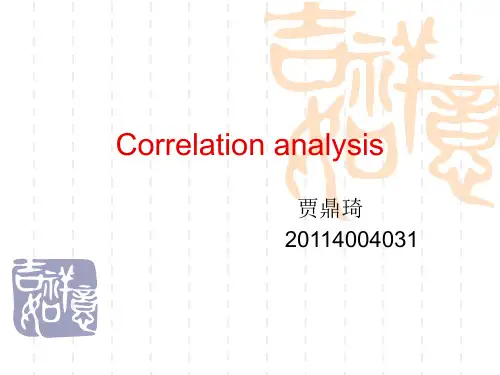
Correlation coefficient(相关系数)
The definition of Correlation coefficient: It measures the strength and direction of a linear association between two variables.
Correlation coefficient(相关系数)
A correlation coefficient is said to be significant if it reaches the significant level of 0.05, 0.01, or 0.001. (p213) If the probability(出错概率) is bigger than 0.05, the correlation coefficient obtained is regarded as insignificant.
Correlation analysis
贾鼎琦 20114004031
1. The definition of correlation
Correlation(相关性) is a term that refers to the strength of a relationship between two variables. A strong, or high, correlation means that two or more variables have a strong relationship with each other while a weak, or low, correlation means that the variables are hardly related.
相关分析(Correlate)
相关分析(Correlate)Correlation and dependenceIn statistics, correlation and dependence are any of a broad class of statistical relationships between two or more random variables or observed data values.Correlation is computed(用...计算)into what is known as the correlation coefficient(相关系数), which ranges between -1 and +1. Perfect positive correlation (a correlation co-efficient of +1) implies(意味着)that as one security(证券)moves, either up or down, the other security will move in lockstep(步伐一致的), in the same direction. Alternatively(同样的), perfect negative correlation means that if one security moves in either direction the security that is perfectly negatively correlated will move by an equal amount in the opposite(相反的)direction. If the correlation is 0, the movements of the securities are said to have no correlation; they are completely random(随意、胡乱).There are several correlation coefficients, often denoted(表示、指示)ρ or r, measuring(衡量、测量)the degree of correlation. The most common of these is the Pearson correlation coefficient, which is sensitive only to a linear(只进行两变量线性分析)relationship between two variables (which may exist even if one is a nonlinear function of the other).Other correlation coefficients have been developed to be more robust(有效的、稳健)than the Pearson correlation, or more sensitive to nonlinear relationships.Rank(等级)correlation coefficients, such as Spearman's rank correlation coefficient and Kendall's rank correlation coefficient (τ) measure the extent(范围)to which, as one variable increases, the other variable tends to increase, without requiring(需要、命令)that increase to be represented by a linear relationship. If, as the one variable(变量)increases(增加), the other decreases, the rank correlation coefficients will be negative. It is common to regard these rank correlation coefficients as alternatives to Pearson's coefficient, used either to reduce the amount of calculation or to make the coefficient less sensitive to non-normality in distributions(分布). However, this view has little mathematical basis, as rank correlation coefficients measure a different type of relationship than the Pearson product-moment correlation coefficient, and are best seen as measures of a different type of association, rather than as alternative measure of the population correlation coefficient.Common misconceptions(错误的想法)Correlation and causality(因果关系)The conventional(大会)dictum(声明)that "correlation does not imply causation" means that correlation cannot be used to infer a causal relationship between the variables.Correlation and linearityFour sets of data with the same correlation of 0.816The Pearson correlation coefficient indicates the strength of a linear relationship between two variables, but its value generally does not completely characterize their relationship. In particular, if the conditional mean of Y given X, denoted E(Y|X), is not linear in X, the correlation coefficient will not fully determine the form ofE(Y|X).The image on the right shows scatterplots(散点图)of Anscombe's quartet, a set of four different pairs of variables created by Francis Anscombe. The four y variables have the same mean (7.5), standard deviation (4.12), correlation (0.816) and regression line (y = 3 + 0.5x). However, as can be seen on the plots, the distribution of the variables is very different. The first one (top left) seems to be distributed normally, and corresponds to what one would expect when considering two variables correlated and following the assumption of normality. The second one (top right) is not distributed normally; while an obvious relationship between the two variables can be observed, it is not linear. In this case the Pearson correlation coefficient does not indicate that there is an exact functional relationship: only the extent to which that relationship can be approximated(大概)by a linear relationship. In the third case (bottom left), the linear relationship is perfect, except for one outlier which exerts enough influence to lower the correlation coefficient from 1 to0.816. Finally, the fourth example (bottom right) shows another example when one outlier(异常值)is enough to produce a high correlation coefficient, even though the relationship between the two variables is not linear.(离群值可降低、也可以增加数据的相关性。
社会心理名词解释
1.联结(association):是两种刺激在大脑形成暂时神经联系。
用联结可以解释人社会心理现象与行为。
2.强化(reinforcement):这是强化理论最核心概念,其含义是,人们之所以学会某种行为,是因为这种行为能产生令人愉快后果,或满足自己某种需要;人们之所以防止某种行为,是因为这种行为会给人带来不愉快后果。
3.模仿(imitation):个体在社会生活中,主动仿效他人言行社会心理现象。
米勒与多拉德(Miller & Dollard)认为,可以通过延伸刺激—反响关系与强化概念来理解模仿心理机制。
4.自我价值:自我价值(self-worth)即个人选择一定价值标准对自身进展价值评判获得关于自身总体价值概念。
5.自我价值定位:自我价值定位(self-worth positioning)指选择什么样价值标准来评价自身价值。
不同个人自我价值定位可能是高度不同。
6.自我价值感:自我价值感(feeling of self-worth)指个人对自身价值评判结果体验。
7.自我价值支持:个人以自我价值感形式表现出来自我价值状况,是由两个根本性因素决定,一是自我价值支持,一是自我价值定位。
前者是客观自我价值依托,后者是自我价值诠释体系。
8.自我价值保护:自我价值保护(self-worth defense),那么是指人为了保持自我价值确立,心理活动各个方面都有一种防止自我价值遭到否认自我支持优势心理倾向。
9.关系解释研究:又称相关研究(correlational research),是考察两个或更多变量(即现象)相互关系,提醒一个变量是否受其它变量影响,影响程度与性质如何,进而用一个变量预测另一个变量研究方法10.档案法:档案分析法(archival analysis)简称。
它是根据一定目,搜集各种现存发表与虽未发表但是通过系统方法记载〔如论文、地方志〕知识载体,通过对文献研究形成对事实科学认识方法,借以提醒特定社会行为与心理现象与某些社会条件之间依存关系一种方法。
研究思路和方法英语
研究思路和方法英语Research is a systematic and rigorous process of inquiry that aims to expand our understanding of the world around us. It involves the collection, analysis, and interpretation of data to answer specific questions or test hypotheses. Researchers employ a variety of approaches and methods to conduct their investigations, each with its own strengths and limitations. In this essay, we will explore some of the key research approaches and methods commonly used in various fields of study.One of the primary research approaches is the quantitative approach, which focuses on the collection and analysis of numerical data. This approach is often associated with the scientific method, which involves the formulation of hypotheses, the design of experiments or surveys, and the statistical analysis of the resulting data. Quantitative research is particularly useful for identifying patterns, trends, and relationships between variables, and it can provide precise and objective measurements. Examples of quantitative research methods include experiments, surveys, and secondary data analysis.In contrast, the qualitative approach emphasizes the understanding of human experiences, behaviors, and social phenomena. This approach typically involves the collection of non-numerical data, such as interviews, observations, and document analysis. Qualitative research aims to gain a deeper understanding of the subject matter, often by exploring the perspectives and experiences of the participants. This approach is particularly useful for understanding complex social and cultural phenomena, and it can provide rich and nuanced insights. Examples of qualitative research methods include ethnography, phenomenology, and grounded theory.Another important research approach is the mixed-methods approach, which combines elements of both quantitative and qualitative research. This approach allows researchers to take advantage of the strengths of both approaches, providing a more comprehensive understanding of the research problem. Mixed-methods research can involve the concurrent or sequential collection and analysis of quantitative and qualitative data, with the goal of triangulating the findings and gaining a more complete picture of the phenomenon under study.In addition to these broad research approaches, there are numerous specific research methods that researchers can employ. One of the most common is the case study, which involves an in-depth examination of a single or small number of cases. Case studies canprovide detailed and context-specific insights, and they are particularly useful for exploring complex, real-world phenomena. Another popular method is the survey, which involves the collection of data from a sample of a larger population using questionnaires or interviews. Surveys can provide a broad overview of attitudes, behaviors, and characteristics, and they are often used in fields such as social science and market research.Experimental research is another widely used method, particularly in the natural sciences and psychology. Experiments involve the manipulation of one or more independent variables to observe their effect on a dependent variable, with the goal of establishing causal relationships. Experiments can be conducted in controlled laboratory settings or in natural settings, and they can be either observational or interventional.Correlational research is another approach that focuses on identifying relationships between variables, without necessarily establishing causality. This method is often used in fields such as psychology and sociology, where it can be difficult to establish causal relationships due to the complexity of human behavior and social phenomena.Finally, secondary data analysis involves the use of existing data sets, such as census data or government records, to answer new researchquestions. This approach can be cost-effective and time-efficient, and it can provide valuable insights that may not be available from primary data collection.Each of these research approaches and methods has its own strengths and limitations, and the choice of approach and method will depend on the specific research question, the available resources, and the researcher's philosophical and methodological orientation. Ultimately, the goal of research is to expand our understanding of the world and to inform decision-making and problem-solving in a wide range of fields.。
correlation
correlationCorrelationIntroductionCorrelation is a statistical measure that determines the degree to which two variables are related to each other. It is an important concept in many fields, including statistics, economics, social sciences, and healthcare. In this document, we will explore the concept of correlation, its types, and its significance in various applications.What is Correlation?Correlation quantifies the statistical relationship between two variables. It measures how changes in one variable correspond to changes in another variable. Correlation is typically represented by the correlation coefficient, which ranges from -1 to +1. A positive correlation indicates a direct relationship, while a negative correlation indicates an inverse relationship. A correlation coefficient close to zero indicates a weak or no relationship between the variables.Types of CorrelationThere are three main types of correlation: positive correlation, negative correlation, and zero correlation.1. Positive Correlation: When two variables increase or decrease together, they are said to have a positive correlation. For example, there is a positive correlation between the amount of study time and test scores. As the study time increases, the test scores also tend to increase. The correlation coefficient for a positive correlation ranges from 0 to +1.2. Negative Correlation: In contrast to a positive correlation, a negative correlation exists when one variable increases while the other decreases. For instance, there is a negative correlation between the number of hours spent watching TV and academic performance. As the hours spent watching TV increase, the academic performance tends to decrease. The correlation coefficient for a negative correlation ranges from 0 to -1.3. Zero Correlation: Zero correlation, as the name suggests, implies no relationship between the variables. The changes in one variable do not correspond to any changes in the othervariable. When the correlation coefficient is close to zero, it indicates a weak or no correlation.Significance of CorrelationCorrelation has several practical applications in different fields.1. Statistics: Correlation analysis is used to determine the strength and direction of the relationship between variables. It helps statisticians to understand the patterns and trends in data. Correlation coefficients are widely used in regression analysis and predictive modeling.2. Economics: In economics, correlation analysis helps to identify relationships between different economic variables such as inflation and unemployment rates, interest rates and investment, or GDP and consumer spending. Understanding these relationships is essential for making informed economic decisions.3. Social Sciences: Correlation is used in social sciences to study various phenomena, such as the relationship between education and income, crime rates and poverty, or healthbehaviors and disease outcomes. Correlation can provide insights into social trends and patterns.4. Healthcare: Correlation plays a crucial role in healthcare research. It helps to identify risk factors, assess treatment effectiveness, and understand the relationship between lifestyle choices and health outcomes. For example, studying the correlation between smoking and lung cancer can help healthcare professionals develop effective prevention strategies.ConclusionCorrelation is a powerful statistical tool that measures the relationship between two variables. It helps us understand how changes in one variable relate to changes in another variable. By analyzing correlation coefficients, we can determine the strength and direction of the relationship. Correlation has wide-ranging applications in statistics, economics, social sciences, healthcare, and other fields. Understanding correlation is essential for making informed decisions and drawing meaningful conclusions from data.。
